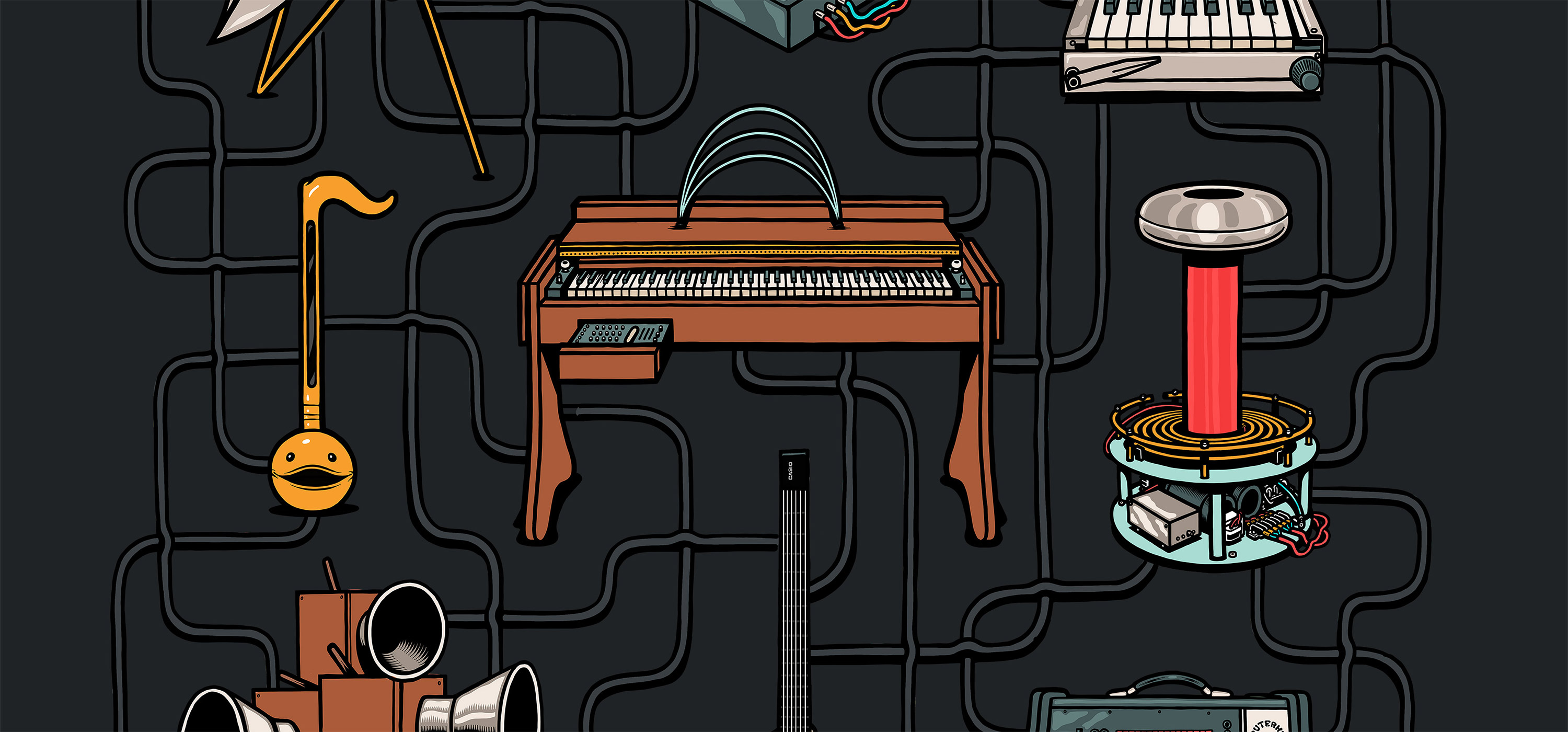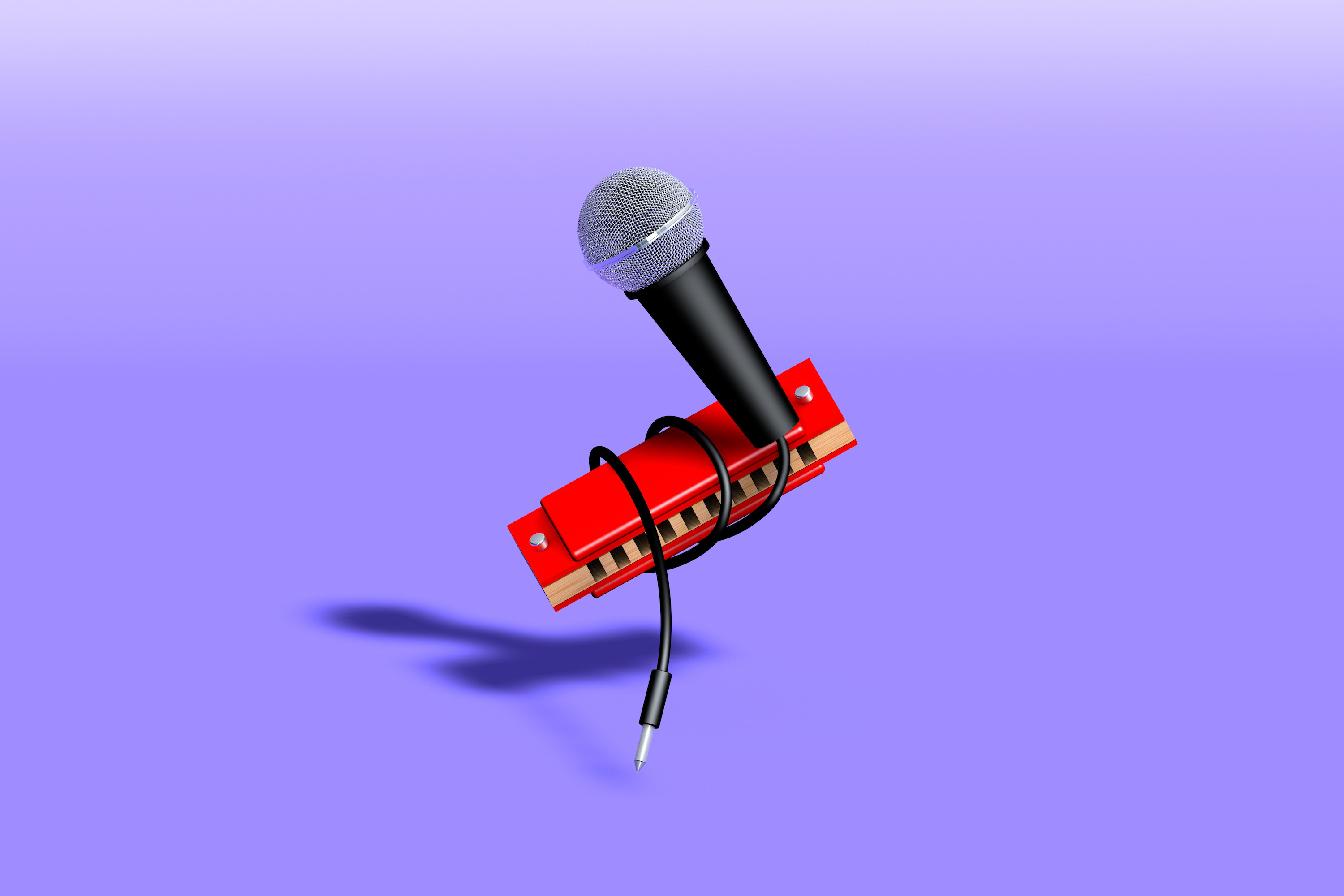
Collaborative Instruments
An illustrated history of remarkable instruments devised for two or more players
When some scrappy electronic musicians were developing improvisational groups of humans and computer networks in San Francisco in the late 1970s, they broke with the single-minded computer music conventions of decades prior. “Instead of trying to eliminate the imperfect human performer,” wrote Tim Perkis, a member of the League of Automatic Human Composers and the Hub, “we try to use the electronic tools available to enhance the social aspect of music making.”
This spirit of collaboration – especially when applied to musical instruments – bridges cultural divides, crosses generations and dissolves ego. From East African log xylophone players working together to achieve a sound greater than the sum of its parts, to the Appalachian couple dueting on a courting dulcimer before sharing their lives together, instruments that require multiple players simultaneously enhance and transcend individuality. Some may exist more as a novelty item or creative commentary than as a lasting tool for music-makers, but their unique intentions stand out nonetheless.
Here, we take a look back at some of the most remarkable collaborative instruments through the ages.

Log Xylophones / Amadinda (300 – 1400 AD)
“I must emphasize that these rhythms as heard do really exist, and are not the product of phantasy [sic],” wrote ethnomusicologist Gerhard Kubik in 1962 on the inherent note patterns of log xylophones. “The image as it is heard and the image as it is played are often different from each other in African instruments.” Today, musical cognition is nothing new, but when Kubik started his research in the late 1950s, it was not widely known that the human ear can be tricked by a technique called interlocking, native to various forms of Central and East African music.
The amadinda and its cousin, the akadinda, are central to Uganda’s Buganda people, played exclusively in the service of the king’s royal court until the end of the Buganda Kingdom in 1966, when the instrument and its traditions were disseminated more widely. There are three instrumental sections that require individual players, each using a pair of mallets: the okunaga (“to lead in”), the okwawula (“to divide”) and the okukoonera (“to knock”). Each part has a different sequence of notes that weave in and out of each other like a braid, giving listeners the impression they’re hearing repetitive phrases which aren’t actually written into the original composition. It’s the aural equivalent of an optical illusion.
Organistrum (Late 10th – Early 11th Century)
The organistrum is a precursor to the hurdy-gurdy – a hand-cranked, stringed oddity used by Japanese experimental icon Keiji Haino and Deep Purple’s Ritchie Blackmore. One player turns the crank, which is attached to a leather wheel that rubs internal strings like a violin bow, generating a pitch which is then adjusted by another player pulling keys, called tangents, at the instrument’s other end.
Landing somewhere between the harpsichord and the cello, the organistrum’s sound can also be traced to Leonardo da Vinci’s sketches of the similar viola organista in the 15th century. The instrument’s name is a portmanteau of instrumentum and organum, a term referring to ancient harmonies made up of octaves accompanied by intervals of fourths and fifths. First recognized and explained by music theorist, composer and Benedictine monk Hucbald in 880 AD, this musical notation became a core tenet of Western music theory.
Change Ringing (Early 17th Century)
Change ringing, the practice of tolling church bells in mathematically timed coordination, has been around for hundreds of years, almost as long as many of today’s most most iconic bells. Weighing between 100 and 3600 pounds, these bronze behemoths last for such a long time that they’re putting their manufacturers out of business. “We cast two for Westminster Abbey in 1583 which are rung virtually every day and there’s absolutely nothing wrong with them,” said Alan Hughes, owner of England’s Whitechapel Bell Foundry, which has been around since 1570. “It’s very depressing.” Despite the dwindling number of opportunities for bell-makers, change ringing guilds around the world are actively recruiting new members, starting at the tender age of 10 to 12.
Change ringing isn’t physically taxing, but the order in which the bells are rung can be mind-bogglingly complex, and requires exceptional communication and synchronicity between ringers. A “change” is the equivalent of a permutation, and no permutation can be repeated, which means that every round the bells have to be rung in a different order. Due to the lack of available space and hands, sheet music isn’t used in the belfry, so each ringer must commit to memory instructions – known as methods – and all their variants, with names like Plain Bob Royal, Plain Bob Cinques and I Can’t Believe It’s Not Plain Bob Treble Place Minor. Who said change ringers don’t have a sense of humor?
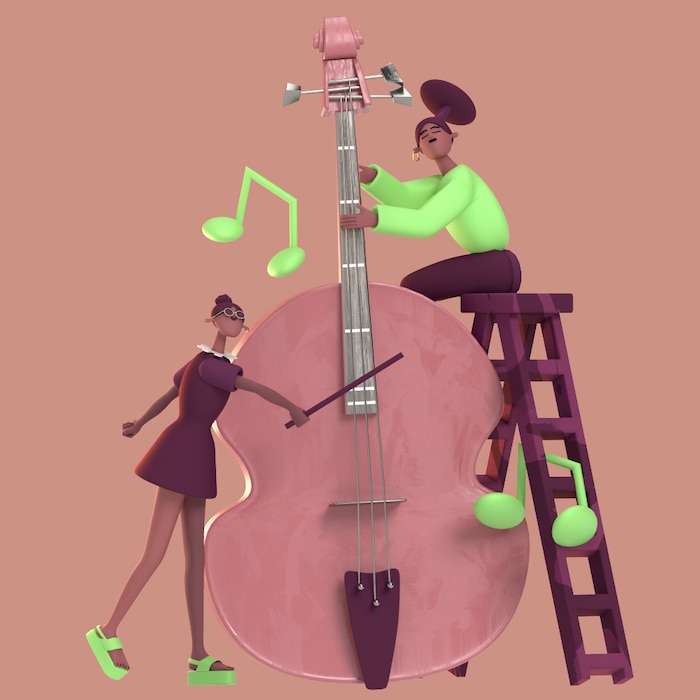
Octobass (1850)
This oversize viola is about twice the height of a double bass and so low-pitched that its lowest C is tuned beyond the range of human hearing. Standing up to 12 feet tall, the first octobass was built in 1850 by French luthier Jean-Baptiste Vuillaume. He added levers and foot pedals to dampen strings on the uppermost reaches of the fingerboard, which could be operated by one or two players, one to bow and one to change pitch. Though composer Hector Berlioz incorrectly predicted the octobass’s widespread mainstream usage, it was integrated into symphonies by Mahler, Wagner, Brahms and Tchaikovsky. Not bad!
Accounts of Brobdingnagian stringed instruments date back centuries. An 1872 issue of German newspaper Die Gertenlaube tells of a bass so large it was partially powered by a windmill at a 1615 Dutch concert. Some of the largest were built in the United States around the turn of the last century: The Chicago Opera Company commissioned a mechanically operated 13-foot double bass from German luthier Otto Roth in 1905, and 1889’s Cincinnati Music Festival featured a 15-footer that was dismissed as a novelty because it was simply too big.

Courting Dulcimer (Mid-1800s)
If you think modern love is bad, try dating in the rural American South in the mid- to late 1800s. When a man was trying to woo a woman, her family would leave them alone together only if they were accompanied by a courting dulcimer. Requiring two players, the oval-shaped instrument occupies both sets of hands, so the sound of music from the other room meant they were behaving themselves. If all went smoothly, on their wedding day the pair’s “song” would be played on the very same model that brought them together.
For at least a century, musicologists have made a case for the “hog fiddle” to be taken seriously, rather than dismissed as an old-fashioned relic of a bygone era. Though there has been some renewed interest throughout the 20th century, no one got their hopes up. Even dulcimer evangelist Charles Seeger (yes, Pete’s father) noted in 1958’s quarterly Journal of American Folk Music, “There is no telling, of course, what effect the present mild popularity of the instrument in the cities will have upon its overall currency among the people at large.” He might be pleased, then, to see that in some areas of the country today, the tradition is alive and well with both old and new couples.
Terpsitone (1932)
Using the same technology as his namesake instrument, Léon Theremin created the terpsitone in 1932 for his wife, prima ballerina Lavinia Williams. Named after the Greek muse of dance, Terpsichore, this unwieldy device’s centerpiece is a metal plate that produces a hard-to-control, eerie wail as one or more dancers moves on top of it. The entire set-up also includes an interconnected system of multicolored lights, which were set off by different musical notes “played” by the dancers.
While Theremin was in Moscow teaching family and friends how to use the terpsitone (his second cousin twice removed has the only one still in existence), John Cage was complaining about theremin conductors in New York City. “When Theremin provided an instrument with genuinely new possibilities,” he writes in 1937’s The Future of Music: Credo, “Thereministes did their utmost to make the instrument sound like some old instrument, giving it a sickeningly sweet vibrato, and performing upon it, with difficulty, masterpieces from the past.”
By 1965, however, Cage and long-time collaborator and choreographer Merce Cunningham had become thereminists of a sort themselves, adapting the terpsitone’s setup for Variations V. In what’s considered one of the earliest multimedia productions, performers could trigger sound audio-visually with motion-sensing onstage antennas and stage lights. Though Cage did succeed in exploring the theremin’s “genuinely new possibilities,” the piece may have been a bit too forward-thinking for the audience, which didn’t seem to understand the link between music and movement.
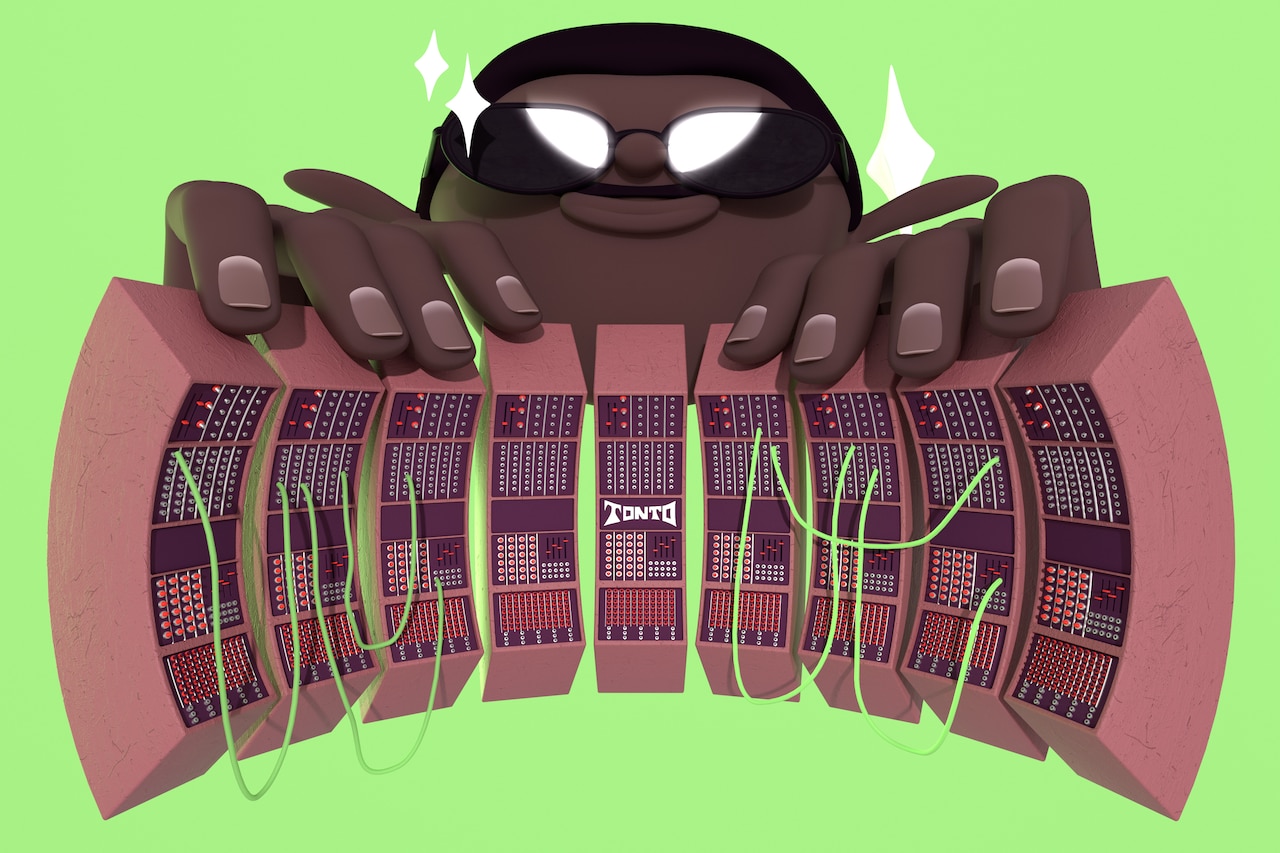
TONTO (1970)
In a 1971 documentary about The Original New Timbral Orchestra, a Frankensteinian contraption of ARPs, Moogs and other modules from manufacturers including EMS, Oberheim, Roland and Yamaha, Malcolm Cecil coaxes birds chirping and waves crashing from his and producer Robert Margouleff’s creation: the world’s first and largest multitimbral polyphonic analog synthesizer. “Normally these instruments don’t like to play together, they don’t like to talk to each other,” he says. “TONTO is the means of doing that.”
Around the same time, Stevie Wonder had just heard Tonto’s Expanding Head Band’s full-length debut Zero Time. Newly freed from his Motown contract and intrigued by the album’s vivid textures, psychedelic melodies and whatever sounds a track title like “Jetsex” brings to mind, he visited Cecil and Margouleff in their studio. They steered Stevie away from the upright bass (they said it was too jazzy) and encouraged him to explore TONTO’s low-end instead, which would go on to define ’70s classics like Innervisions and Music of My Mind.
TONTO’s futuristic synth-funk could be heard on albums by Gil Scott-Heron and Brian Jackson, Joan Baez, Quincy Jones, Bobby Womack and the Isley Brothers. The beloved synth monstrosity also made cameos in Brian De Palma’s 1974 rock opera Phantom of the Paradise and, memorably, in Guillermo del Toro’s opening for a “Treehouse of Horror” episode on The Simpsons. But according to Cecil, the holy grail of synthesizer’s best days are ahead. “It was built 45 years ago and it was 45 years ahead of its time,” he said shortly before it was moved to Calgary’s National Music Centre, where it currently resides. “So now is TONTO time.”
League of Automatic Music Composers (Late 1970s – 1990s)
Along with their peers in the Hub, this collection of Mills College-orbiting DIY experimentalists pioneered computer network music. Regarded as an elder statesman of this community, Jim Horton was among the first to buy early microcomputer model KIM-1, released in 1976, and rewire its silicon neural pathways for music composition. (Maybe not what Byte Magazine had in mind when they suggested readers “Make a date with KIM!”)
Starting in 1977, anywhere from two to four composers – including computer music trailblazer John Bischoff and multimedia artist Paul Kalbach – would perform live with KIMs linked so they could interact. As League participants learned how to code individual algorithms, their computer’s specific programming generated solo compositions that could be reworked in real time to fit with what other members brought to the session. It was a complicated and cumbersome process, but they still “sounded like a band of improvising musicians,” George Lewis is quoted as saying in 1985’s Composers and the Computer.
Lewis, the trombonist, scholar and founding member of the Association for the Advancement of Creative Musicians, still defends artificial musical intelligence against charges that it is replacing living, breathing human instrumentalists. “At the moment at which musical improvisation with machines enacts this radical fluidity of identity,” he writes in The Oxford Handbook of Algorithmic Music, “what we have is not a simulation of musical experience, but music making itself — a form of artificial life that produces non-artificial liveness.”
Global String (1999 – 2000)
“Someday anyone with a modem can have the same experience of a concert as the people who are actually there,” wrote The Village Voice’s Kyle Gann in 1987, while reviewing a New York City concert by computer network-based improvisational sextet the Hub, performing in two different locations connected by a modem. Gann didn’t exactly nail it – he predicted composers would conduct symphonies via rotary phone, and music critics would review concerts remotely – but he wasn’t far off. People can watch concerts via livestream, and some critics do indeed review them. But Gann would have had to be psychic to predict that some digital media artists and engineers would modernize the Hub’s original idea.
In 2000, Professor Atau Tanaka and his team strung a resonant cable diagonally between the ceiling and the ground as part of an installation for forward-thinking art platform V_2. As the student of John Cage manipulated his steel wire in Linz, Austria, the physical vibration was converted into digital form via software, which traveled through a shared server to another user in Rotterdam, the Netherlands. That individual then tugged on his own wire, which in turn sent a pulse rippling back through cyberspace to Linz, where the virtual vibration initiated the movement of the original wire.
Professor Tanaka and his colleagues Zbigniew Karkowski and Edwin van der Heide have also formed their own trio, Sensorband, described as “a sensor instrument ensemble, meaning that each member plays a unique instrument that uses the body to make music.” When not in the same room, they jammed together over an ISDN connection.

Tooka (2004)
Though this peculiar flute was modeled after early collaborative improvisational organizations like the League of Automatic Music Composers and the Hub – both of which connected musicians over computer networks – it’s a little more intimate, even downright awkward. Players breathe each other’s air, duck and bob together like synchronized snake charmers, and maintain eye contact for a socially unacceptable long time.
Made of two mouthpieces connected by a clear plastic tube, the tooka employs an air pressure sensor connected to an amplifier. Each player adjusts the sound using four keys, a white for octaves, red for sustaining certain sounds and two black keys for notes. Compared to other woodwinds, they must make much greater use of cheek muscles and tongue movements, giving a whole new meaning to mouth sounds. The University of British Columbia team that invented the instrument also admits there are as-yet-unknown physical factors that could have an effect: “Movement of the torso up and down, head motion, and facial expression may change the pressure in the tube, and result in sonic changes.”
Matt West’s “Collaborative Instrument” (2008)
Designer Matt West’s functional prototype for a two-person instrument generated a bit of a buzz when it first surfaced online, but the project he conceptualized for his BA design degree from Goldsmiths, University of London never made it to distribution. One person controls pitch and the other controls rhythm on a simple, stylish interface, “intending to extend the division of the two functions and experiment with how both musicians communicate with one another,” West wrote. Think of it as a courting dulcimer for couples with short attention spans and a yen for making computer music.
It would have added an extra layer of complexity if this collaborative effort also explored the duality of rhythm and pitch – once the rhythm, also known as beats per minute, accelerates past a certain point, our brain starts to perceive that as pitch – but maybe that’s a topic for West’s master’s degree. Or would be, if he weren’t now running his own pottery studio.

Auerglass (2009)
Bored and restless one night while living together in San Francisco in the early 2000s, visual artist Tauba Auerbach and electro-pop conjurer Cameron Mesirow, AKA Glasser, constructed a banjo out of a cookie tin and some pieces of wood. Six years later, they decided to put their talents to considerably more ambitious use and designed the Auerglass, a two-person pump organ inspired by that initial impetus of friendship and cooperation.
Parsons Pipe Organ Builders in upstate New York realized their vision because “we didn’t know how a wind system works,” admits Auerbach. Consisting of two keyboards – one with white keys, one with black – four bellows, seven different types of wood and 49 pipes, the Auerglass looks a bit like a full-rigged ship on springs from the side. Each composition is partially scored and partially improvised as each player pumps air to the other’s notes, creating a cacophony of shushing leather, lightly clacking pedals and rich, flute-like tones.

Social Lamellophone (2012)
The name of Australian artist Gary Warner’s mbira derivative is perhaps a bit misleading – despite fitting in the hands of a single player, the diminutive wooden and metal African instrument has always been a social tool. Central to community building for the Shona people of Zimbabwe, Zambia and Mozambique, it’s played at weddings and death ceremonies, to inaugurate leaders and celebrate independence, even to communicate with the deceased. Since Zimbabwe’s independence in 1980, the mbira has represented the spirit of resistance to colonialism and the fight for liberation.
Warner took his lamellophone – the technical term for the family of instruments including the mbira – out of its original context by setting it up in an art gallery and removing the typical musical accompaniments, like a singer, drums and seeded gourd shakers known as hosho. Its 270 steel keys are hammered out of street sweeper bristles collected from Sydney city streets over the years – not that much of a stretch from modern-day mbira’s tines, often recycled from bed and couch springs, bicycle spokes and nails. His creation still brings people together, albeit in a slightly different way: “They look like babies playing with a mobile,” commented one viewer.
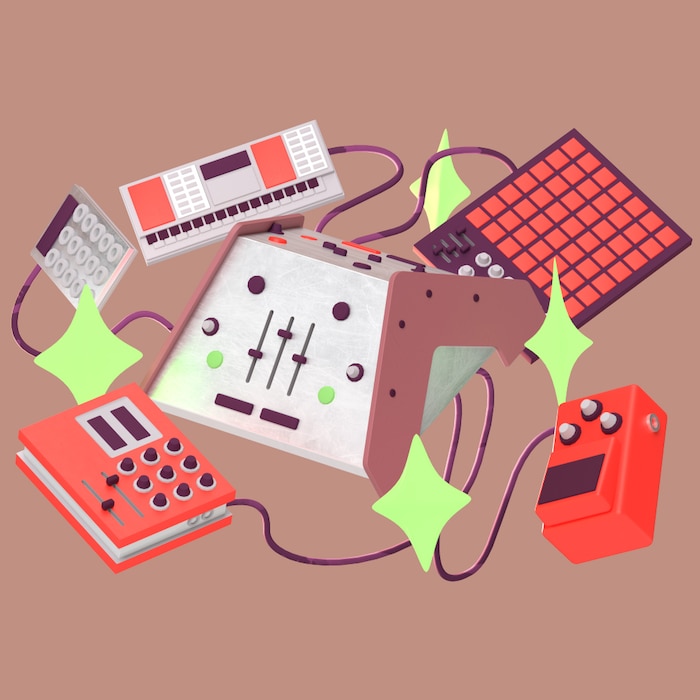
Dato DUO (2016)
In 1984, the New York Times published a trend piece about the rise of portable electronic keyboards like the Casio VL-1. According to industry insiders, growth in the music business at the time was “mostly in electronics, particularly portable, low-power electronic keyboards featuring small microcomputers… Perhaps most importantly, many are battery-powered and small enough to carry under one’s arm.” Not long after that, the Atari ST removed another barrier to entry with its software-based sequencers, which would eventually lead to the boom in pocket synthesizers almost 25 years later.
It wasn’t until 2016 that one of these miniature music-makers became available for multiple players working together. Billed as the first “synth-for-two,” the Dato DUO is, like many childhood board games, for kids ages 3-99. Using buttons, sliders and knobs on opposite sides of the object, one user churns out series of notes while their companion facing them manipulates it with filters, effects like delay and bitcrusher and drum pads. The DUO’s makers are also quick to point out that their invention can be used as part of a larger set-up including travel-sized favorites like Korg’s Volcas and Teenage Engineering’s Pocket Operators.
Header image © Joe Melhuish
